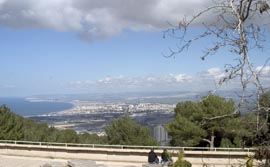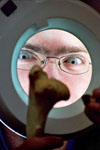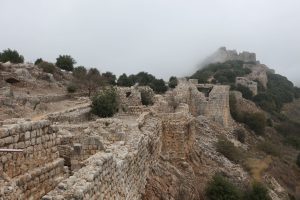In the short space from its establishment, the Zinman institute has left its stamp on archaeological activity in the north of Israel. Its researchers have been involved in a significant number of excavations, surveys, and theoretical studies.
In early 1999, the Institute moved to its new facilities, a refurbished complex of laboratories, study rooms and offices conducive to research and teaching.  Recently, the Institute announced of the building of new additional labs and workshops to facilitate the ever expanding research demands.
Recently, the Institute announced of the building of new additional labs and workshops to facilitate the ever expanding research demands.
Today the Zinman Archaeological Institute is the leading institution in its field in the North of Israel. Institute researchers have been working since its establishment on excavations and surveys of Mount Carmel, the northern coast of Israel, the Jezreel Valley, and the Galilee Mountains. In addition to work in the field, research is carried out in the library and in the Institute’s various laboratories. The chronological framework of the Institute’s activity includes the Prehistoric periods, the Biblical period of the Bronze and Iron Ages, the Classical period, covering the Hellenistic, Roman, and Byzantine eras, the Early Arab periods and finally the Middle Ages.


Researchers of the biblical period have explored, among others, Tel Dor, Al-Ahwatt, Tel Assawir and Tel Shikmona. In addition, the Institute has been carrying out a comprehensive survey in the Carmel, Samaria and the Arabah regions.
Classical Archaeology
 The Classical period ushered in by the confrontation between Eastern and Western cultures in the fourth century BCE saw the development of modern, planned cities and transportation networks. Archaeologists seek to understand the patterns characteristic of this East-West interaction during the Hellenistic, Roman and Byzantine periods. The central sites where Institute researchers have been digging include Caesarea, Sha’ar Ha’amakim, Hippos (Sussita), Horvat Katzion and Tel Shikmona.
The Classical period ushered in by the confrontation between Eastern and Western cultures in the fourth century BCE saw the development of modern, planned cities and transportation networks. Archaeologists seek to understand the patterns characteristic of this East-West interaction during the Hellenistic, Roman and Byzantine periods. The central sites where Institute researchers have been digging include Caesarea, Sha’ar Ha’amakim, Hippos (Sussita), Horvat Katzion and Tel Shikmona. Middle Ages and Late Muslim Archaeology
 Through the Middle Ages, the eastern Mediterranean witnessed many relatively rapid changes, including the arrival of newcomers of various ethnic backgrounds, which brought both flourishment and destruction. The integration and segregation between the locals and the newcomers can be observed through the material culture left behind. The research in our “centre” extensively combines archaeological excavations and topographical studies, with the analysis of historical texts from the early Islamic, Frankish, Mamlūk, and Ottoman periods. The projects carried out deal with various sites situated mainly in the western Upper Galilee, including Montfort Castle, Khirbat al-Manḥata and many sites in the village of Miʿilyā.
Through the Middle Ages, the eastern Mediterranean witnessed many relatively rapid changes, including the arrival of newcomers of various ethnic backgrounds, which brought both flourishment and destruction. The integration and segregation between the locals and the newcomers can be observed through the material culture left behind. The research in our “centre” extensively combines archaeological excavations and topographical studies, with the analysis of historical texts from the early Islamic, Frankish, Mamlūk, and Ottoman periods. The projects carried out deal with various sites situated mainly in the western Upper Galilee, including Montfort Castle, Khirbat al-Manḥata and many sites in the village of Miʿilyā. The Zinman Institute of Archaeology is home to twelve full time researcher, over 20 associate research fellows and more than 50 post graduate research students who investing their research efforts within the frame work of the four major chronological periods, i.e. Prehistoric, Biblical, Classical, Middle-Ages and Late Muslim.
University of Haifa
199 Aba-Hushi Avenue
Haifa
Israel 3498838


